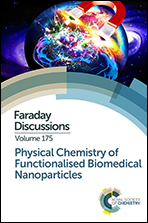Characterization of Ephedrine HCl and Pseudoephedrine HCl Using Quadrupolar NMR Crystallography Guided Crystal Structure Prediction
IF 3.3
3区 化学
Q2 CHEMISTRY, PHYSICAL
引用次数: 0
Abstract
Quadrupolar NMR crystallography guided crystal structure prediction (QNMRX-CSP) is a nascent protocol for predicting, solving, and refining crystal structures. QNMRX-CSP employs a combination of solid-state NMR data from quadrupolar nuclides (i.e., nuclear spin > 1/2), static lattice energies and electric field gradient (EFG) tensors from dispersion-corrected density functional theory (DFT-D2*) calculations, and powder X-ray diffraction (PXRD) data; however, it has so far been applied only to organic HCl salts with small and rigid organic components, using 35Cl EFG tensor data for both structural refinement and validation. Herein, the QNMRX-CSP protocol is extended to ephedrine HCl (Eph) and pseudoephedrine HCl (Pse), which are diastereomeric compounds that feature distinct space groups and organic components that are larger and more flexible. A series of benchmarking calculations are used to generate structural models that can be validated against experimental data, and to explore the impacts of the (i) starting structural models (i.e., geometry-optimized fragments based on either a known crystal structure or an isolated gas-phase molecule) and (ii) selection of unit cell parameters and space groups. Finally, we use QNMRX-CSP to predict the structure of Pse in the dosage form Sudafed using only 35Cl SSNMR data as experimental input. This proof-of-concept work suggests the possibility of employing QNMRX-CSP protocols to solve the structures of organic HCl salts in dosage forms – something which is often beyond the capabilities of conventional, diffraction-based characterization methods.利用四极核磁共振晶体学指导晶体结构预测表征盐酸麻黄碱和盐酸伪麻黄碱
四极核磁共振晶体学指导下的晶体结构预测(QNMRX-CSP)是一种用于预测、解决和完善晶体结构的新兴方案。QNMRX-CSP 将四极核素(即核自旋为 1/2)的固态核磁共振数据、弥散校正密度泛函理论(DFT-D2*)计算得出的静态晶格能和电场梯度(EFG)张量以及粉末 X 射线衍射(PXRD)数据结合起来使用;不过,迄今为止,它只应用于有机成分较少且较硬的有机 HCl 盐,使用 35Cl EFG 张量数据进行结构完善和验证。在本文中,QNMRX-CSP 方案扩展到了盐酸麻黄碱(Eph)和盐酸伪麻黄碱(Pse),这两种非对映化合物具有不同的空间基团和较大且更灵活的有机成分。我们利用一系列基准计算来生成可与实验数据进行验证的结构模型,并探索 (i) 初始结构模型(即基于已知晶体结构或孤立气相分子的几何优化片段)和 (ii) 单胞参数和空间群选择的影响。最后,我们仅使用 35Cl SSNMR 数据作为实验输入,利用 QNMRX-CSP 预测了剂型 Sudafed 中 Pse 的结构。这项概念验证工作表明,可以采用 QNMRX-CSP 协议来解决剂型中有机盐酸盐的结构问题,而这往往是传统的基于衍射的表征方法所无法解决的。
本文章由计算机程序翻译,如有差异,请以英文原文为准。
求助全文
约1分钟内获得全文
求助全文
来源期刊

Faraday Discussions
化学-物理化学
自引率
0.00%
发文量
259
期刊介绍:
Discussion summary and research papers from discussion meetings that focus on rapidly developing areas of physical chemistry and its interfaces
 求助内容:
求助内容: 应助结果提醒方式:
应助结果提醒方式:


